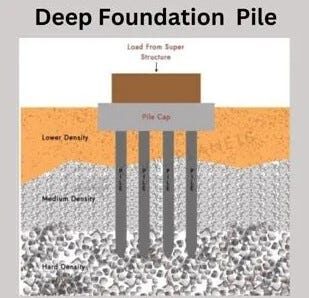What is Foundation Engineering?
Foundation engineering is a sub-discipline of civil engineering that focuses on the design , analysis and construction of foundations for buildings and other structures that support structures and transfer their loads to the underlying soil or rock. It combines principles of soil mechanics, rock mechanics, geotechnical engineering, and structural engineering.
A building’s foundation transfers the structure’s load to the ground and provides stability against overturning and sliding. Foundation design requires an understanding of the underlying soil or rock and its ability to adequately support the loads imposed by the structure. This often requires site investigation techniques like drilling boreholes to determine subsurface conditions.
Key considerations in foundation design include bearing capacity, settlement, and global stability. Proper foundation design is crucial for preventing settlement or collapse of structures. Foundation engineers must consider both short-term and long-term performance issues.
Importance of Foundation Engineering in Civil Engineering
Foundation engineering plays a critical role in civil engineering projects. The foundation is what transfers structural loads from a building or infrastructure into the underlying soil or rock. Proper foundation design and construction is essential for ensuring the overall stability and performance of civil engineering structures.
Foundation engineering expertise is needed on most construction projects, from small residential buildings to massive bridges and skyscrapers. Without strong, stable foundations, civil engineering structures run a high risk of excessive settlement or even collapse. Knowledge of soil mechanics, rock mechanics, and subsurface conditions is required to design foundations that will adequately support the planned structure.
Civil engineering students study foundation engineering to gain core competencies in geotechnical analysis, soil bearing capacity, pile foundations, footings, and foundation performance issues like differential settlement.

Practicing civil engineers collaborate closely with specialized geotechnical and foundation engineers on projects. Overall, foundation engineering represents a foundational discipline within civil engineering that underpins the structural integrity and longevity of buildings, bridges, dams, and other key infrastructure.
Robust foundations are crucial in civil engineering projects. Foundation engineering:
- Ensures stability against overturning, sliding, uplift and settlement.
- Transmits superstructure loads properly into the ground.
- Protects against ground movements and vibrations.
- Provides appropriate support for type of structure.
Principles of Foundation Engineering
Here are some key principles of foundation engineering:
- Load Transfer – A fundamental principle is that foundations transfer the loads from a structure to the underlying soil or rock. The foundation must do this without exceeding the bearing capacity of the substrata.
- Settlement Control – Limiting total and differential settlement is crucial to prevent structural damage. Settlement needs to be within tolerable limits for the structure.
- Global Stability – The foundation influences the global stability of slopes and excavations. Stability analyses ensure adequate safety factors against sliding, overturning, and bearing failure.
- Subsurface Investigation – Site exploration techniques like drilling boreholes provide critical data for foundation design. The soil/rock profile and properties must be known.
- Soil-Structure Interaction – There is continual interaction between the foundation, soil, and structure. This interaction needs to be understood through soil mechanics and structural principles.
- Design Codes – Foundation design incorporates relevant building codes and geotechnical design codes for issues like bearing capacity, settlement, and seismic design.
- Performance Monitoring – The performance of foundations is monitored over time. Instrumentation like settlement monitoring guides maintenance actions.
- Economics – Foundation selection balances engineering requirements with initial and life cycle economic considerations.
- Safety Margins – Appropriate factors of safety are incorporated in foundation design calculations for bearing capacity, settlement, and overall stability.
- Constructability – The constructability of the foundation design using available techniques and materials is evaluated.
- Site Conditions – Foundations are designed based on the specific conditions at a site, considering the climate, topography, soil/rock type, groundwater, etc.
- Sustainability – Sustainable and environmentally-responsible foundations are designed where feasible.

Foundation engineering design considerations
Here are some of the key factors considered in foundation engineering design:
- Soil conditions – The type of soil, its density, shear strength, compressibility, and permeability are assessed through site investigation techniques like borehole drilling and soil sampling. These properties greatly influence foundation design.
- Loadings – The building loads transferred to the foundation include dead loads, live loads, wind loads, and seismic loads. The foundation must be designed to safely support these loads.
- Settlement – Total and differential settlement of foundations must be within tolerable limits for the building or structure. Settlement depends on soil conditions and applied loads.
- Bearing capacity – The foundation must be sized and located such that the soil can support the bearing pressure without shear failure. Bearing capacity depends on soil/rock strength.
- Slope stability – The foundation influences global slope stability. Stability analyses determine the risk of foundation-induced slope failure.
- Water conditions – Depth to groundwater table and potential for water flow/permeability impacts foundation design. Proper drainage may be required.
- Frost depth – Foundations must be below maximum frost penetration depth to avoid frost heave forces.
- Construction materials – The foundation construction materials like concrete, steel, and timber determine the foundation type and design parameters.
- Economics – The cost of foundation alternatives is considered. The design optimizes for safety and function at minimum cost.
- Building constraints – The foundation design must integrate with the structural design and accommodate space limitations.
- Environmental factors – Nearby structures, trees, or soil contamination can influence foundation design.
Proper consideration of these factors results in foundations that safely support structures while minimizing settlement and other issues.
Geotechnical Investigations for Foundation Design
Here are some key points about geotechnical investigations for foundation design:
- Subsurface exploration is crucial to collect soil/rock samples for testing and identify the site’s stratigraphy and groundwater conditions. Common methods include borehole drilling, test pits, cone penetration tests (CPT), and geophysical surveys.
- Laboratory testing on soil/rock samples determines key parameters for design like shear strength, compressibility, permeability, and consolidation characteristics. Common tests include soil classification, moisture content, compaction, triaxial shear, consolidation, and unconfined compression.
- In-situ testing like the Standard Penetration Test (SPT) provides additional data on soil properties directly in the field. This supplements lab testing.
- Bedrock depth and properties are identified if rock will be bearing for the foundation. Rock coring and lab testing provide data on intact rock strength.
- Geotechnical reports summarize the investigation findings including site history, exploration logs, laboratory and in-situ test results, groundwater conditions, and foundation design recommendations.
- The type and amount of subsurface exploration depends on the project scale, structure type, suspected ground conditions, and design team preferences. Budget and timeline also influence investigation scope.
- Building codes often stipulate minimum investigation requirements for various structure classifications. For example, significant geotechnical work is mandated for sites in high seismic zones.
- Geotechnical engineers collaborate with foundation engineers to plan investigations that provide the necessary parameters, samples, and site data to support foundation design with adequate confidence in the ground conditions.
- Ongoing exploration may occur during construction if conditions differ from the initial findings. The investigation aims to identify issues that will impact foundation installation, performance, cost, and schedule.
How do geotechnical engineers collaborate with foundation engineers
some of the ways geotechnical engineers collaborate with foundation engineers on site investigations are :
- Planning meetings – Geotechnical and foundation engineers discuss the project goals, anticipated foundation types, expected ground conditions, and required geotechnical parameters. This informs the investigation scope.
- Borehole spacing and depth – Geotechnical engineers provide recommendations on borehole locations, spacing, and termination depths to provide adequate subsurface coverage for the foundations.
- Testing frequency – The geotechnical engineer advises on the number and types of soil/rock lab tests needed to sufficiently characterize the site and support analyses.
- In-situ testing – The investigation may incorporate standard penetration tests (SPT), cone penetration tests (CPT), vane shear tests, pressure-meter tests, or other in-situ testing to supplement lab data.
- Bedrock investigation – If bearing on rock, rock coring and lab testing on core samples are included.
- Groundwater monitoring – Piezometers or observation wells often monitor seasonal groundwater fluctuations that impact foundation design.
- Geophysical testing – Geophysical methods like seismic refraction, electrical resistivity and ground penetrating radar can help delineate soil/rock strata between boreholes.
- Data sharing – Geotechnical engineers share field logs, lab data, groundwater measurements, and geophysical results with the foundation engineers.
- Design discussions – The teams discuss how site conditions may impact foundation type selection, allowable bearing pressures, settlement estimates, construction feasibility, and costs.
- Supplementary exploration – Additional subsurface exploration is performed if the initial results reveal unexpected conditions or do not provide the needed data.
- Field visits – Joint site visits allow the foundation engineer to observe subsurface conditions and field testing procedures.
- Reporting – Geotechnical engineers document and interpret findings in a report to support foundation design. Recommendations are provided.
Conclusion
Foundation engineering is a complex field that integrates soil mechanics, rock mechanics, geotechnical engineering, structural engineering, and construction knowledge. It involves thorough site investigation to assess subsurface conditions, selection of an appropriate foundation type, analytical design methods, and construction considerations.
Advanced software tools help engineers optimize the foundation system. However, fundamental principles of soil mechanics and critical engineering judgement remain essential. The societal importance of foundation engineering cannot be overstated, as the foundation influences structural integrity and safety.
Proper foundation design minimizes the risks of excessive settlement and collapse of civil engineering projects. It provides the critical interface between a structure and the ground that supports it through the integration of geotechnical knowledge, structural design, analytical methods, and construction expertise.






